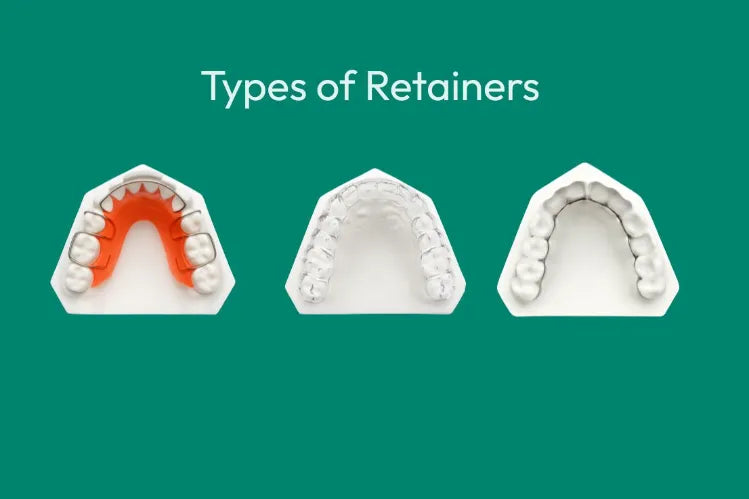
Table of Contents
- Why Retainers Matter More than You Think
- Permanent Retainers: The Set-It-and-Forget-It Option
- Removable Retainers: Flexibility at Your Fingertips
- Permanent vs. Removable Retainers: A Head-to-Head Comparison
- Types of Retainers after Braces
- Cleaning and Maintenance: Non-Negotiable
- Mouth Guards vs Retainers: What’s the Confusion?
- Costs: What to Expect
- Lifestyle Factors to Consider
- How Smilepath Helps You Stay Aligned
- Permanent vs Removable: Which One Should You Choose?
- FAQs
Finally, you’ve come to the end of your braces or clear aligners process. Your teeth are straight, your smile looks incredible, but the last step is keeping the teeth where they are supposed to be. This is where retainers come into play. Retainers do not give you a choice; they are necessary. If you don’t wear a retainer, your teeth will begin to shift back to their previous positions (and no one wants to spend months or even years working on straightening their teeth, just to have them revert).
The question you’re probably asking yourself is whether you should have permanent vs removable retainers. Both have advantages and disadvantages. The right option will depend on your lifestyle, your budget, and how consistent you are with your oral hygiene.
In this guide, we provide a side-by-side comparison with helpful advice and a look at how Smilepath can help you keep that dream smile for years to come.
Why Retainers Matter More than You Think
Think about nurturing a lovely garden all spring long. You plant, water, and care for it until it is just so. Then you stop caring for it, and weeds grow up and undo all of your hard work. That is what happens to your teeth, too. Soon after you have them aligned, the process called orthodontic relapse gets into motion if you don’t use a retainer.
What are retainers ? Designed for each individual separately, retainers are devices that maintain your teeth in place to resist relapse. They help stabilize your teeth while your other supporting structures, including your gums and bone, adapt to your teeth in their new positions. Most orthodontists suggest lifetime retention, but that usually means nights turned into every other night, then every few nights.
Wouldn't you skip this step? Honestly, it'd be like leaving that garden of yours to shame if you don't use your retainer.
Read more about: Can retainers move teeth back
Permanent Retainers: The Set-It-and-Forget-It Option
A permanent retainer, also called a fixed retainer, is a thin metal wire that’s glued to the back of your teeth. Usually, it’s placed on the bottom front teeth, but sometimes it’s added to the top as well.
How They Work
The wire is bonded to each tooth with dental cement. Because it’s hidden behind your teeth, no one will see it, but it’s always there, quietly doing its job 24/7.
Pros of Permanent Retainers:
- You can’t lose it. It stays in place all the time.
- No need to remember to wear it.
- Provides consistent retention.
- Great for people prone to relapse, especially on the bottom teeth.
- Works silently in the background without effort.
Cons of Permanent Retainers:
- Harder to clean around. Flossing takes extra effort.
- If the wire breaks, your teeth can shift quickly.
- Not ideal for people who like the smooth feel of their teeth.
- Some may feel irritation at first.
Tip: A permanent retainer is especially helpful for keeping your bottom retainer area stable. The lower teeth are notorious for shifting the fastest.
Removable Retainers: Flexibility at Your Fingertips
As the name suggests, removable retainers can be taken out whenever you need to. There are two main styles:
- Hawley Retainer: The classic design with a thin metal wire in front and acrylic material that rests against the roof of your mouth or behind your lower teeth.
- Clear Plastic Retainer: Similar to clear aligners, these are almost invisible and fit snugly over your teeth.
Why People Love Them
- Easy to clean.
- It can be removed for eating or special occasions.
- Clear retainers are nearly invisible.
- Allow for natural flossing and brushing.
- Give a sense of freedom compared to fixed wires.
Challenges of Removable Retainers
- You must remember to wear them.
- Easier to misplace (or accidentally toss in the trash).
- Pets, especially dogs, love to chew on them.
- Need periodic replacement due to wear and tear.
Story time: A client once shared how her dog mistook her clear retainer for a chew toy. It cost her $200 to replace it. Keep them in a case, folks!
Permanent vs. Removable Retainers: A Head-to-Head Comparison
Here’s a quick table to help you see the differences at a glance:
| Feature | Permanent Retainer (Fixed) | Removable Retainer |
|---|---|---|
| Visibility | Hidden behind teeth | Clear or metal wire visible |
| Maintenance | Harder to floss around | Easy to clean and floss |
| Compliance Required | None (always working) | Must remember to wear |
| Comfort | May cause slight tongue irritation | Smooth, no permanent feeling |
| Risk of Loss | Cannot be lost | Can be lost or damaged |
| Cost Over Time | One-time fee, occasional repairs | May need replacements |
| Best For | Those prone to relapse or forgetful wearers | People who want flexibility |
Types of Retainers after Braces
When you finish your orthodontic treatment, it's essential to maintain the alignment of your teeth to prevent them from shifting back to their original positions. Your orthodontist will likely recommend one of the following three retainer options, each with its own unique features and benefits:
Fixed Retainer (Permanent)

This type of retainer is a great choice for individuals who struggle with stubborn lower teeth that are prone to shifting. A fixed retainer consists of a thin wire bonded to the back of your teeth, ensuring they remain in place. It's often paired with a removable top retainer, providing double protection during the retention phase. The advantage of a fixed retainer is that you don't need to remember to wear it, as it's always in place.
Hawley Retainer

This is a classic and durable removable retainer made of a combination of plastic and wire. The wire component is placed in front of your teeth, making it more visible than other options. However, this design allows for easy adjustments if minor shifts in your teeth occur. The Hawley retainer is also adjustable, meaning it can be fine-tuned over time to ensure the best fit and effectiveness. With proper care, it can last for several years, making it a reliable option for many patients.
Clear Plastic Retainer

Ideal for those who enjoy the discreet nature of clear aligners, these retainers are lightweight and virtually invisible when worn. They snugly fit over your teeth, providing a comfortable solution for maintaining your smile. However, it’s important to handle them with care, as they can be prone to cracking if not stored or handled properly. Clear plastic retainers are particularly popular among adults and teens who prefer a more subtle option for maintaining their teeth after orthodontic treatment.
Each retainer type has its own advantages, so it's important to discuss your lifestyle and preferences with your orthodontist to determine the best option for you. Proper use of the recommended retainer will help ensure that your beautiful smile lasts for years to come.
Read more about: How long retainers last
Cleaning and Maintenance: Non-Negotiable
Maintaining proper hygiene with your retainer is essential for oral health. Regardless of the type of retainer you opt for, whether it's fixed or removable, neglecting it can result in plaque accumulation, which can lead to various dental issues.
Poor hygiene can not only cause bad breath but may also contribute to cavities and gum disease. Regular cleaning of your retainer will help prevent these problems and ensure that your smile remains healthy and vibrant. It's important to follow the recommended care guidelines and incorporate good oral hygiene practices, such as brushing your teeth and the retainer itself, to keep your mouth fresh and free from harmful bacteria.
For Permanent Retainers:
- Use floss threaders or water flossers to get between teeth.
- Visit your dentist regularly to check for loose spots in the wire.
- Avoid biting into very hard foods directly with your front teeth.
- Consider professional cleanings more frequently to prevent tartar buildup.
For Removable Retainers
- Rinse them after every meal.
- Brush gently with a soft toothbrush, no toothpaste, as it can scratch.
- Soak in a retainer cleaner or mild denture solution weekly.
- Keep them in a case when not in use.
- Never expose them to boiling water or direct sunlight.
Pro Tip: Never leave your removable retainer wrapped in a napkin. That’s the #1 reason they end up in the trash.
Mouth Guards vs Retainers: What’s the Confusion?
Some people confuse night guards or mouth guards with retainers. They’re not the same thing, but they can work together.
- A night guard protects against teeth grinding (bruxism). Some retainers double as night guards, especially those made of thicker plastic
- A mouth guard is for sports and doesn’t keep teeth aligned. However, if you play contact sports, wear a mouth guard over your permanent retainer to protect both your teeth and your appliance.
Smilepath offers solutions that blend the benefits of clear retainers and night guards, making it easier to protect your smile around the clock.
Costs: What to Expect
When considering orthodontic retainers, it's important to keep in mind that prices can differ widely based on various factors, including the specific type of retainer you choose and the regional pricing practices of dentists in your area. Here’s a more detailed breakdown of what to expect in terms of costs:
- Permanent Retainers: These are typically bonded to the back of your teeth and can range from $250 to $600 per arch. This is generally a one-time placement cost, but it’s worth noting that maintenance may be required over time.
- Hawley Retainers: A more traditional option, Hawley retainers usually cost between $150 and $300. They are adjustable and can be personalized, allowing for a comfortable fit as your mouth changes.
- Clear Plastic Retainers: Known for being nearly invisible, clear plastic retainers like those offered by Smilepath are popular among adults and teens. They are generally priced at $199 per set, making them a more affordable option compared to other types.
However, consider the potential expense of needing replacements. Losing a removable retainer can come as an unexpected financial hit, so planning is wise.
For those looking for a cost-effective solution, Smilepath offers clear retainer plans that include backups. This means you won't have to worry about being unprotected in case of loss or damage. With these plans, you can enjoy peace of mind knowing that you have support in maintaining your smile.
Lifestyle Factors to Consider
Before you decide, think about how each type of retainer fits into your daily routine.
- Travel a lot? A fixed retainer is low-maintenance, but removable ones are easier to clean on the go.
- Forgetful? Go permanent. You can’t forget what’s glued in place.
- Social butterfly? Clear removable retainers let you smile confidently in photos.
- Sports player? Consider having a backup mouth guard to wear during games.
Your lifestyle matters just as much as your dental needs.
How Smilepath Helps You Stay Aligned
Smilepath isn’t just about straightening teeth. Once your smile is aligned, we make sure it stays that way. Our clear retainers are designed to be comfortable, durable, and virtually invisible, ideal for anyone transitioning from clear aligners or looking for a sleek alternative to traditional retainers.
Why people choose Smilepath:
- Affordable pricing with no surprise fees.
- Custom-fit retainers made from high-quality materials.
- Easy online ordering and home delivery.
- Replacement options so you’re never without a backup.
Permanent vs Removable: Which One Should You Choose?
Here’s the truth: there’s no right answer. If you are forgetful or do not wish to put the responsibility of wearing your retainer every night on yourself, then a permanent retainer is probably the best option for you.
If you think about nighttime wear too much, or if you like being able to take your retainer out for cleaning or special occasions, then a removable retainer would better suit your needs.
Some people even use both, a fixed bottom retainer for continuous stability, and a clear top retainer at night for additional wear. It's sort of like having a safety net for your safety net!
Whatever you decide, don't wait too long! Teeth move faster than people realize. Plus, with everything you've been through to get to that smile, it deserves to last forever!
Smilepath has made it easier and more affordable to protect your perfect smile!
FAQs
Yes, slight shifting can happen, especially if the retainer breaks or loosens.
With proper care, they can last 5–10 years, sometimes even longer.
They can contribute to gum problems if you don’t keep them clean or skip dental checkups.
Use a floss threader or a water flosser to get between the teeth and under the wire.
People prone to forgetting removable retainers or with a history of crowding in their lower teeth.
Yes, tartar can build up around the wire if you don’t clean carefully and visit your dentist regularly.
Citations:
DeDentistry & Orthodontics. https://wwntistry, B. (n.d.). Permanent vs. Removable Retainers: Keeping Your Smile Straight. BLVD w.blvddentistry.com/permanent-retainer-vs-removable-reta
Higuera, V. (2019, December 20). Pros and cons of permanent retainers. Healthline. https://www.healthline.com/health/permanent-retainer







 Australia
Australia New Zealand
New Zealand Malaysia
Malaysia English
English Portuguese
Portuguese English
English English
English English
English English
English English
English Canada
Canada